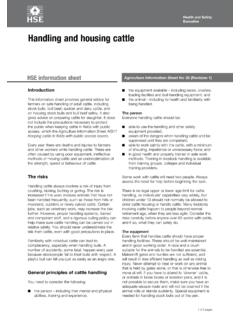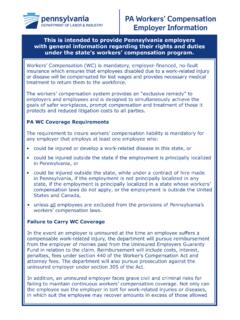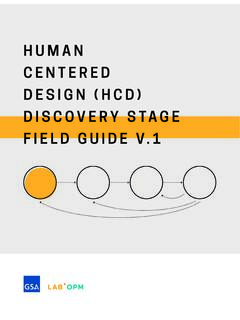Transcription of Short Guide Summarising the Oil and Gas Industry Lifecycle
1 ECONOMIC AND PRIVATE SECTOR PROFESSIONAL EVIDENCE AND APPLIED KNOWLEDGE SERVICES HELPDESK REQUEST Short Guide Summarising the oil and gas Industry Lifecycle for a non-technical audience Emily Darko Overseas Development Institute October 2014 i EPS-PEAKS is a consortium of organisations that provides Economics and Private Sector Professional Evidence and Applied Knowledge Services to the DfID. The core services include: 1) Helpdesk 2) Document library 3) Information on training and e-learning opportunities 4) Topic guides 5) Structured professional development sessions 6) E-Bulletin To find out more or access EPS-PEAKS services or feedback on this or other output, visit the EPS-PEAKS community on or contact Alberto Lemma, Knowledge Manager, EPS-PEAKS core services at Disclaimer Statement: The views presented in this paper are those of the authors and do not necessarily represent the views of Consortium partner organisations, DFID or the UK Government.
2 The authors take full responsibility for any errors or omissions contained in this report. ii Contents Abbreviations iii 1 Timelines and actors in the oil and gas Industry Lifecycle 1 The five phases of upstream oil and gas Industry Lifecycle 1 Actors 3 Factors influencing the timing of oil and gas exploration and production 4 2 How and when revenues from the oil and gas Industry flow to host governments 5 Fiscal revenues throughout life cycle 5 Factors affecting revenue flows 6 Non-revenue benefits to host governments and communities 7 References 9 Annex 1 - Revenue Life Cycle 10 Annex 2 Non-revenue domestic benefits Lifecycle 11 iii Abbreviations IOC International Oil Company IPIECA International Petroleum Industry Environmental Conservation Association LNG Liquefied Natural Gas NOCs National Oil Companies PSA Production Sharing Agreement
3 PSC Production Sharing Contract PPT Petroleum Production Tax This document provides a brief outline of the lifecycles of the oil and gas Industry . It aims to explain to governments, communities, citizens and local companies how and to what extent they can expect to benefit from the oil and gas Industry . The Guide has been informed by interviews with Shell, BG Group, BP plc, Tullow Oil and IPIECA. Due to time constraints we have not been able to include interviews with a wider set of actors and stakeholders. Title 1 1 Timelines and actors in the oil and gas Industry Lifecycle The five phases of upstream oil and gas Industry Lifecycle Oil and gas sector comprise three main activities - upstream (exploration and production), midstream (transportation and processing1) and downstream (distribution and sale to end users/consumers).
4 This paper presents a simplified generic life cycle focused on the involvement of an international oil company (IOC) in the upstream oil and gas In reality, Industry operations can be far more complex3 this paper aims to set out the basic principles. Five phases of the upstream life cycle are used as a framework to present processes in the upstream Industry . Midstream and downstream activities are developed in the develop phase and occur concurrently with the produce phase. Annex 1 presents a basic representation of revenue flows during a basic oil or gas block/license life cycle, based on the timing suggestions from two sources: Dietsche et al (2013) and Tullow Oil s Life Cycle document. These timings are based on broad generalisations about the length of different processes, which in reality are dependent on a range of factors, outlined below.
5 These average figures are only intended to be indicative. There are five phases to the life cycle of upstream oil and gas Industry : Phase Timing Activities 1. Explore 1-5 years Exploration for potentially viable oil/gas sources through geological surveys. Government seeks investment for own exploration or grants access for firms to explore, through direct negotiation or bidding processes. Concessions may be awarded to international companies to explore in a particular geographical area, with contracts governing the rights to any oil or gas discovered agreed. Duration of licenses and permits varies by country and by licence or block. International companies may explore alone or two or more companies may form joint ventures to explore together with one company being appointed the operator.
6 Often no potentially viable oil/gas sources are discovered and operations are terminated. Where potentially viable oil/gas sources are identified, further exploration will occur. Companies will develop work plans for the next phase. Investment will be made in the technical and commercial components of exploration and also in social and environment impact assessments. 2. Appraisal 4-10 years Sites identified as potentially containing viable oil/gas sources are examined in more detail. Infrastructure may be developed to access sites. Site drilling is planned and exploratory wells are drilled to seek to discover and map oil/gas reserves. Depending on the location of the field, companies will engage with communities as their operations increasingly impact on the local environment and economy.
7 1 In the case of LNG, processing may happen at the production site: as such it happens prior to transportation, and means that the mid-stream phase also affects communities from which oil/gas is being extracted. 2 In recent years, there has been increased interest in processing oil products locally in developing countries because of the potential benefits from processing crude oil to the wider economy (job creation and skills enhancement in manufacturing and services industries). This is more the case for oil than gas, which is more complex and expensive to process and transport. This note does not cover midstream processes. 3 For example, it would be quite normal that several fields/blocks are being explored and exploited at the same time. Thus, on the side of government the impacts of various licence/block lifecycles would be cumulative, for example with respect to the macro-economy and revenue collection.
8 Title 2 If no commercially viable oil/gas is identified, operations will be terminated. Where oil/gas reserves are deemed commercially viable, exploration companies will prepare to develop the site. 3. Develop 4-10 years Government contracts and permits may be revised/renewed and the site is prepared for production. Limited infrastructure and site development will already be in place as part of the exploratory and initial drilling phase, but during the field development phase activity will dramatically increase and first oil/gas will be produced towards the end of this phase. 4. Produce 20-50 years Oil/gas reserves are being extracted and transported for processing and distribution. There is uncertainty in any field about the amount of oil/gas, so it can be difficult to predict the volume of production which will fluctuate across this phase, with the rate of extraction typically rising to a peak and tapering off towards the end of the field s commercial lifetime (Collier, 2012).
9 5. Close 2-10 years Once it is no longer cost-effective to extract remaining reserves, the site is decommissioned and the operating companies are typically responsible for returning the site to as close to original state as possible. This phase can take decades if environmental monitoring is required. It is important to note that in the majority of instances activity is unsuccessful at the explore and appraisal phase no potentially viable oil/gas sources are found, or when exploration wells are drilled no oil/gas is discovered or the reserves are not sufficient to justify the size of investment required to extract them. The majority of projects will therefore not reach stages 3,4 or 5 of the life cycle described above. Distinguishing oil and gas lifecycles Conventional oil production refers to the extraction of petroleum consisting of crude oil.
10 Gas occurs in two forms, associated gas a by-product of oil production, extracted via oil fields, and non-associated gas, which is extracted separately to oil where no oil is found (BG, 2010). Conventional oil and gas life cycles are broadly similar, but there are differences. In terms of production peaks oil fields tend to peak early in the production phase and have a longer decline whereas gas production tends to produce more steadily with regular fluctuations throughout the production phase. Oil may also be easier to process, transport and sell. Gas is more expensive to transport, difficult to store and commands a lower price per unit of energy than oil. Although the development of the process of liquefied natural gas (LNG)4 has helped address this problem and made it viable to develop gas fields for export over longer distances than is normally possible by pipeline, the cost of significant upfront capital investment (BG, 2010) means that extraction can only be justified by much larger reserves of gas, compared to those required for oil and associated gas.

















